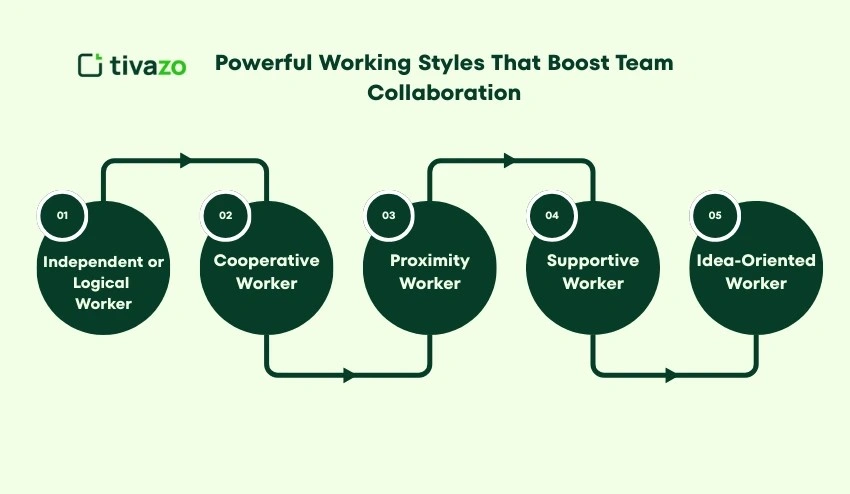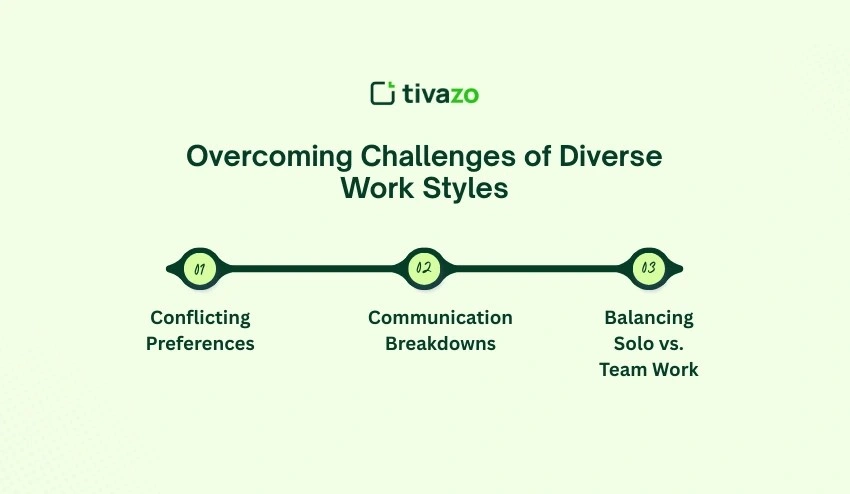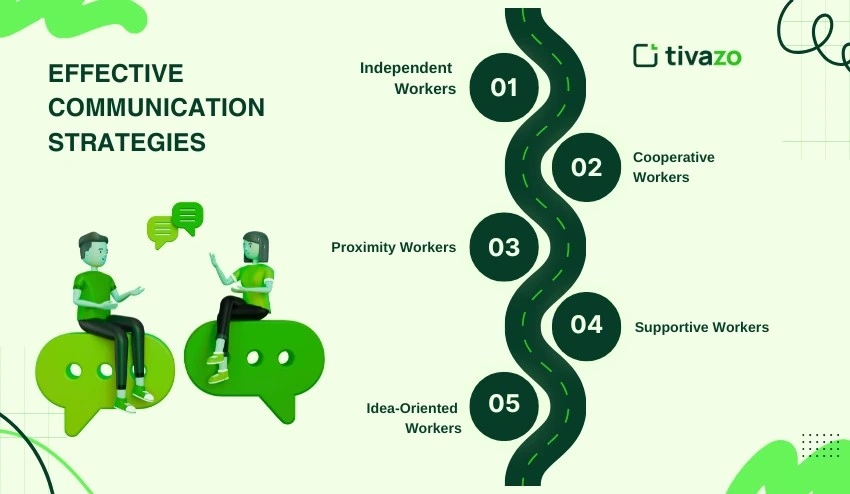In the modern work context, teams are more diverse than ever before. Everyone on the team has their own approach to work, from problem-solving to communication. Understanding and working with these working styles can greatly enhance team dynamics, productivity, and creativity.
But how can you do this? In this blog post, we will introduce you to 5 working styles that can help improve collaboration in teams and influence better outcomes together.
Key Highlights:
- What Are Working Styles
- Powerful Working Styles That Boost Team Collaboration
- Identify Your Own Work Style
- Leverage Different Work Styles
- Overcoming Challenges of Diverse Work Styles
- Effective Communication Strategies
What Are Working Styles?
Working styles are the ways individuals choose to engage with work. Everyone has a preference for how they prefer to work (or at least feels they do), and these styles can directly impact how your teammates have conversations and work on and complete team projects.
For example, some individuals enjoy autonomy and like to work by themselves, while others are more productive when they are deliberating closely with others and throwing ideas back and forth. When you can identify working styles, you may be able to direct the way you lead and the way your team engages with the work so that it can fit better into each person’s style. Working styles can help you direct efforts toward alignment, become less friction-minded, and simply improve team dynamics.
5 Powerful Working Styles That Boost Team Collaboration
All teams will have a combination of these working styles. Here is how each working style can bring value to collaboration:

1. Independent or Logical Worker
Independent workers are natural problem solvers who work best with some autonomy. They are usually visionary, able to dissect large problems into manageable tasks and independently find solutions others have not thought about. While they tend to work heavily on assigned work individually, they do tend to enjoy constructive feedback from their teammates along the way to assess if they are aligned with the overall project objectives.
- Brings innovation and new ideas to the team.
- Can solve complex problems and come up with a visionary idea that advances the team.
Example:
A software engineer doing discovery work on a new feature is one example of a worker that can analyze an issue and generate solutions on their own. They thrive under independence but benefit from any input that will shape or assure their solution fits within the project plan.
2. Cooperative Worker:
Collaborative workers thrive in environments that require teams, sharing, and collaboration. They enjoy being able to talk, share ideas, and listen to input from others. Because of their effective communication, they are often the ones who facilitate conversations to ensure that everyone’s perspective is included, making them a needed part of the team.
- Facilitates discussions about teams and listens to everyone’s perspective.
- Contributes to an open conversation that attempts to keep the team together.
Example:
A project manager is a good example of a collaborative worker. They build a team’s spirit, manage the dynamics of the team and help move things along the way, sometimes unstuck. Because of their communication and engagement with everyone, they often manage things so the team can continue progressing.
3. Proximity Worker
Proximity workers represent the continuous flexibility between completing an independent task and team collaboration. Depending on where the task requires them or to provide feedback, they can flex, multi-task, juggle, focus, and generally get the work done, all while maintaining engagement with the team for feedback and alignment.
- Represents the blended activity between personal productivity and social collaborative work by moving in both spaces at the same time.
- Can easily transition from independent work to collaborative work or a combination of both to ensure progress.
Example:
A marketing specialist may develop content or conduct research independently, while also looking to solicit input from their colleagues during the review phase to improve ideas and characterize both the approach and the strategy of the team.
4. Supportive Worker
Supportive workers offer empathy, emotional intelligence, and conflict resolution skills. They serve as the emotional centers of the team who can help ensure that everyone feels valued. Supportive workers can also sense when something is wrong, and they will alleviate problems or provide support to restore a more positive team culture. Supportive workers are valuable for performing tasks related to shared decision-making as it relates to responsibilities and for maintaining a healthy team environment to promote team collaboration.
- Creates a positive team environment by alleviating negative emotions and conflict to support morale.
- Helps mediate conflict and also ensures that everyone feels valued, so the trust level increases for the team.
Example:
A human resources manager who proactively checks in on the group’s interpersonal dynamics and resolves interpersonal challenges between colleagues supports the team in balancing their work without ongoing distractions or unresolved interpersonal tensions.
5. Idea-Oriented Worker
Idea-oriented workers are forward thinkers who have an innovative mindset. They tend to be the creative energy of the team, always seeking to formulate new ideas. They enable the team to think beyond traditional solutions and drive the team toward new opportunities. Their consideration of higher-level goals and development of the vision enables the team to establish a plan, but they may lean on other team members to work out specific execution and details.
- Encourages creativity to expand and pushes team members to view things in new ways, which encourages ideas that are innovative.
- Helps drive the vision of the team forward, ensuring the team remains focused on bigger picture goals and long-term planning.
Example:
A creative director who is charged with offering new campaign ideas and inspiring others to think differently from each other or the team has traditional campaign execution. However, they can lean on others to figure out the organization and planning of the ideas they create.
How to Identify Your Own Work Style
Another useful approach to learning about your work style is to compare your behaviors and preferences to those of your co-workers. By watching how others handle tasks, you can identify your own work tendencies.
- Observe Your Habits:
- Pay special attention to your natural work habits. Do you prefer independent work, or do you find more satisfaction working with groups of individuals? Look for clues about whether you tend to be a big picture thinker or someone who enjoys the details. Your work habits can signal whether your work style is more independent, collaborative, or idea-oriented.
- Ask Yourself:
- Think about what excites you at work? Do you derive energy from resolving problems independently, or do you enjoy brainstorming with others? The answers to these questions may provide clues about whether your work style is independent and solitary, or collaborative and social.
- Use Online Tools:
- Consider using tools like Myers-Briggs or StrengthsFinder to gain more insight into your working style. These tests can help you understand your communication preferences, decision-making processes, and how you approach problem-solving, all of which are essential for identifying your dominant style.
After you learn your own style, you are on the road to being able to communicate better with others and adapt your approach for collaboration.
How to Leverage Different Working Styles for Better Team Collaboration
Now that you have identified the different working styles of your team, it is time to leverage the styles to maximum effect. Here’s how:

- Mix Strengths: Partner workers with complementary styles. For example, someone who is idea-oriented might want to partner with someone who is detail-oriented so that you can have creative thinking with some degree of accuracy.
- Encourage Communication: Create an environment that supports open communication in which everyone feels supported in expressing ideas and giving or receiving feedback. You might, for example, use a tool like Slack or Microsoft Teams to keep everyone engaged and connected, especially if your team is dispersed.
- Match Tasks to Strengths: Match the tasks to the individual’s strengths. For example, assign brainstorming ideas to Idea-oriented individuals and tasks that entail a lot of detail to detail-oriented individuals.
When you understand and appreciate different working styles, you now have a team that can be more harmonious and get better results.
Overcoming Challenges of Diverse Work Styles
Distinct working styles within groups can often create friction within teams, but there are ways you can use those working styles to your advantage:

- Conflicting Preferences:
- For example, independent workers thrive on autonomy, while cooperative workers like instant feedback. Work together to establish mutually beneficial expectations with clear boundaries. In turn, it will also establish mutual respect for others’ needs, too.
- Communication Breakdowns:
- Different working styles can create communication issues, which can lead to miscommunication. Make it a habit to set up frequent follow-up appointments to clarify communication methods. Be open to feedback and work to establish a culture of honest yet open feedback.
- Balancing Solo vs. Team Work:
- Offer flexibility for solo or team-based tasks and balance this out by way of regular feedback loops to optimize collaboration. Solicit input recognition of both group and solo work.
Effective Communication Strategies for Different Working Styles
When you understand work preferences regarding communication, you can more effectively collaborate. The following suggestions can enhance communication with varied working styles.

- Independent Workers:
- Communication with independent workers should be uncomplicated and efficient. They prefer to operate in independent, self-directed situations so they do not micromanage. Instead, give independent workers explicit, written instructions when feasible so they can address an assignment without needing to interact with you too frequently. Your check ins should have minimal interaction, focusing on outcomes instead of process and providing workers with adequate time to work independently.
- Cooperative Workers:
- Cooperative workers maintain a connection and momentum with regular feedback and interaction. They appreciate some verbal exchange, as they need engagement from others in the working environment. Provide cooperative workers with regular opportunities to brainstorm and share dialogue during meetings and other times. Providing regular interaction should help maintain cooperative workers’ engagement and motivation in a team setting.
- Proximity Workers:
- Proximity workers appreciate balance; therefore, provide opportunities to work alone without losing check-ins that help digital workers stay on the same page. Be mindful of proximal workers’ need to work independently and collaboratively — they do not need to be bothered all the time, but they do need help sometimes and need to maintain the collaboration with others.
- Supportive Workers:
- Supportive workers respond better with personalized and empathetic communication. They enjoy forming bonds with others and are encouraged by their teammates’ well-being. Take time to listen to their concerns, thank them for contributing, and provide opportunities for them to help others.
- Idea-Oriented Workers:
- Allowing idea focused workers the freedom to malinger and generate ideas is important, but ensure there’s a way to organize those ideas into manageable tasks. Foster creativity, and then implement processes with clear deadlines to keep the team focused on completing tasks and seeing results.
Leadership Strategies for Managing Diverse Working Styles
Leaders are an important part of managing working styles. Here are leadership strategies that work:
- Adapt Your Leadership Style:
- Good leaders know along the spectrum of empowering and guiding a worker to where they specifically fit into that style. When working with Independent workers, empower them to approach the challenges on their own. When working with Cooperative workers, the agent provides structure and finds a rhythm to give feedback, reinforce goal pursuit, plan action tasks, and determine what can be done next. Adjusting your leadership style permits every team style to receive support and reach its full potential.
- Offer Tailored Coaching:
- Provide a coach to support and fit the individual workers’ unique working styles. For workers who are idea-focused, allow them freedom of creativity to encourage unconventional thinking, as well as a process in place for their ideas to become actionable items. For workers who are detail-focused, provide specific constructive feedback and printouts so they can see the whole picture when appropriate to avoid the paralysis of perfecting the task.
- Encourage Collaboration:
- Foster a culture where all working styles are respected and valued. Engage in team-building activities to inspire everyone to get to know each other’s strengths and preferences. Once workers recognize and understand each other’s styles they will collaborate more effectively and be even more innovative, blending their varied strengths.
Conclusion
Understanding and respecting each member’s work style is transformational for team collaboration. By identifying each person’s strengths so that you can cargo to their communication styles or discovery of preferences, you build a team that not only collaborates effectively, but flourishes.
Today I challenge you to take action by assessing your own work style and sharing it with the rest of your team. The knowledge will help you function more effectively and nurture a collaborative culture that will take you to greatness.


